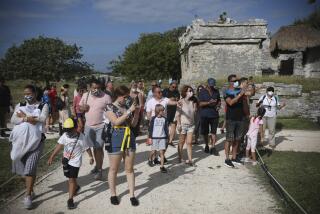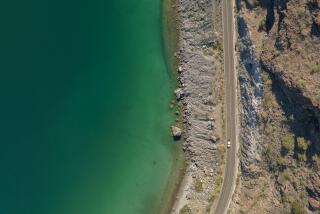Easygoing Comes Easy on Cozumel
- Share via
COZUMEL, Mexico — Hundreds of fish no longer than a little finger swim slowly around us, just below the surface of the warm and translucent Caribbean Sea.
Each has a blue stripe that glows in the afternoon sunlight. They are unafraid of our presence, keeping out of contact without any apparent effort to do so. At times they seem to be peering into our snorkeling masks.
A few feet below us, larger fish tinted with bright yellow and aquamarine move in the same leisurely way. The water is so clear that they make shadows on the soft white sand between clusters of coral.
We aren’t swimming and snorkeling off some remote beach on Mexico’s Caribbean island of Cozumel. The underwater tranquillity around us is right in front of the El Presidente Hotel. We have left our towels on beach chairs and walked right into a surf that is little more than a ripple.
Home of the Goddess
We’ve been living life at the same pace ever since we stepped off the small plane after a 20-minute flight from Cancun City on the mainland of the Yucatan Peninsula. It’s easy to understand why the ancient Maya people believed Cozumel to be the home of the Goddess of the Moon, who was also their goddess of love.
Each laid-back day has given us the leisure to discover something that wasn’t apparent during our previous visit here by cruise ship. Within its length of about 35 miles and widest width of less than 10 miles, Cozumel is in effect many islands to be explored and enjoyed without a sense of rushing from one interest or activity to another.
The carnival season before Lent brought us close to the people of Cozumel. Early-evening parades started several days before Ash Wednesday, first with the smallest children in costumes and on floats, continuing with the next older group of youngsters for each successive parade. The children also danced around the plaza and for the hotel guests while parents beamed.
Relaxation’s the Rule
Even with as many as three cruise ships reaching Cozumel on the same day, we haven’t found a sense of rush around the downtown shopping area of the island. Cruise passengers are already relaxed by the time they land here--and they stay that way.
We’ve been varying our enjoyment of the Caribbean waters with explorations of the island in a rental car that’s a story in itself. The smiling young Mexican at the Avis desk offered us a choice of a Jeep or “a very nice sedan.” We chose the latter, a VW bug, comfortable enough on the coastal road and exactly right for rough inner-island roads.
In the forest at El Cedral on the south end of the island we found a harmony of ancient times and today. A small cluster of wooden shelters for people and livestock looked up to the ruins of a Mayan temple beside a one-room village church. Fresh flowers had just been placed on the altar table below the crucifix.
Mayas crossed the dozen miles of the Yucatan channel to Cozumel as early as AD 300. They called it Ah-Cuzamil-Peten (place of the swallows). The island became a ceremonial center and an important port for export commerce with people at least as far away as Honduras.
Seven Maya sites can be reached by car around the island. The largest and most frequently visited is San Gervasio, at the end of a short dirt road off the surfaced cross-island road.
Origins Unearthed
Harvard University studies of this great ceremonial center were undertaken in 1980 and have determined that it was begun about AD 1250. The Mayas had placed gold, jade, pottery and other offerings under the altars, but most had been looted in the centuries before the site was overgrown by jungle.
A self-guided tour along walking paths around the ceremonial center leads to chapels, altars, tombs, carvings, stone paintings and the ruins of what are believed to have been a residential sector for the political and religious elite.
The first Spanish explorer to arrive was Juan de Grijalva, who came from Cuba in 1518. The first Catholic Mass was celebrated at a site commemorated by a small church near the main downtown plaza.
Cortez landed here with his ships and troops. He found no gold but did learn about a Spaniard who had survived a shipwreck and married the daughter of an Indian chieftain on the nearby mainland. The man became his interpreter during Cortez’s conquest of the Aztec empire.
Cozumel, which is believed to have had as many as 50,000 inhabitants at the height of the Maya classic era, gradually became almost uninhabited. It was a refuge and staging base for Sir Francis Drake, Henry Morgan, Jean Lafitte and others who plundered Spanish galleons and ports.
Air Base in WWII
During World War II, a U.S. air base was built over Maya ruins. In the 1950s the island began rebirth as a health resort, then took off as a tourism destination after Jacques Ives Cousteau discovered Palancar and other reefs and proclaimed Cozumel a diver’s paradise.
Now tourism has helped to rebuild the population to about 40,000, and there are more beaches and reefs than Maya ruins to intrigue visitors. We’ve counted at least a dozen reefs that would rank as top diving locations in the Caribbean, and every resort hotel along what has become the western Gold Coast has its own beach of silken white sand and calm waters for swimmers and snorkelers.
Palancar Reef lies about a mile offshore and stretches for three miles over a fantasy of coral formations, some with pinnacles and spires up to 70 feet high underwater. Visibility ranges up to 250 feet in crystalline waters ideal for photography.
Palancar has been made a national park to preserve its ecosystem, and during the past year has become a special kind of underwater sanctuary for divers. A figure of Christ created by sculptor Enrique Miralda was lowered 17 meters beneath the surface last May 3 and secured at the edge of the reef.
Flowers and Fish
Chankanaab Lagoon and Park, 10 minutes south of town and the beginning of the resort coast, is a fish sanctuary as well as a botanical wonderland, with thousands of exotic plants from around the world. Snorkeling and scuba diving, and lessons for both, begin at the shore in an underwater marine park of coral formations.
The Outer Chankanaab Reef is a few hundred yards offshore, with coral caves close to a sunken ship. The restaurant, under a thatched roof and open to the Caribbean breezes, is popular for lunch and dinner. There are dressing rooms, and diving shops for renting gear.
Windsurfing everywhere along the resort coast is a change of action from diving and snorkeling, and Cozumel considers itself the sailfish capital of the world.
Pesca Fiesta 1986, the International Billfish Tournament, celebrates its 15th season and is part of a series of tag-and-release tournaments in April, May and June. Expert fishermen from 20 nations will compete in catching, tagging and releasing the giant fish.
The Museum of Cozumel will open as a tourism attraction this summer. It will have four main exhibit halls, an auditorium, workshops and reading rooms to present the story of the island and stress the importance of preserving the ecological systems of the land and sea.
Sightseeing Under Sail
Another project under way for this year is to equip the Spanish sightseeing galleon Jean Lafitte with masts and sails so it can sightsee the Cozumel coast under sail, without the sound of its engines.
The galleon belongs to the Club Cozumel Caribe resort hotel and is being fitted for sails under the supervision of Harvard scholar and author Clark Vaughan, a sailing enthusiast and friend of the hotel owner, Fernando Barbachano, whose family has helped develop modern tourism in Mexico.
The peso continues to reflect Mexico’s economic problems, and we’ve been getting as high as 460 to the dollar. Prices tend to adjust upward with the exchange rate, but continue to be moderate. Doubles at waterfront hotels are starting from around $70 to $90. A full day on a dive charter boat with two tanks of air is about $35, including a beach buffet.
For details in helping plan a trip to Cozumel and the Caribbean coast of Mexico, contact the Mexican Government Tourist Office, 10100 Santa Monica Blvd., Suite 224, Los Angeles 90067, phone (213) 203-8151.
More to Read
Sign up for The Wild
We’ll help you find the best places to hike, bike and run, as well as the perfect silent spots for meditation and yoga.
You may occasionally receive promotional content from the Los Angeles Times.






